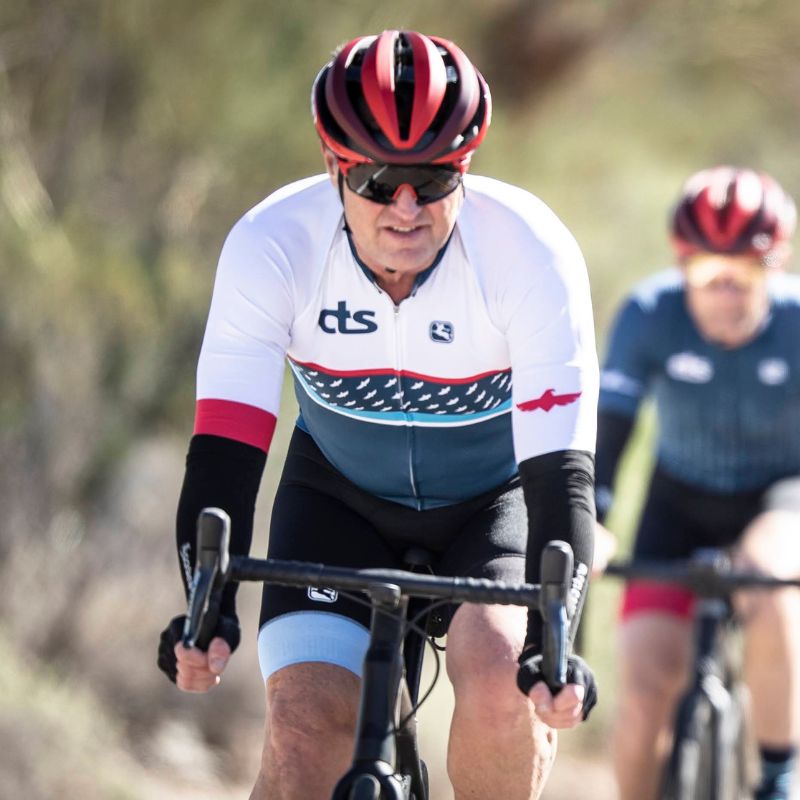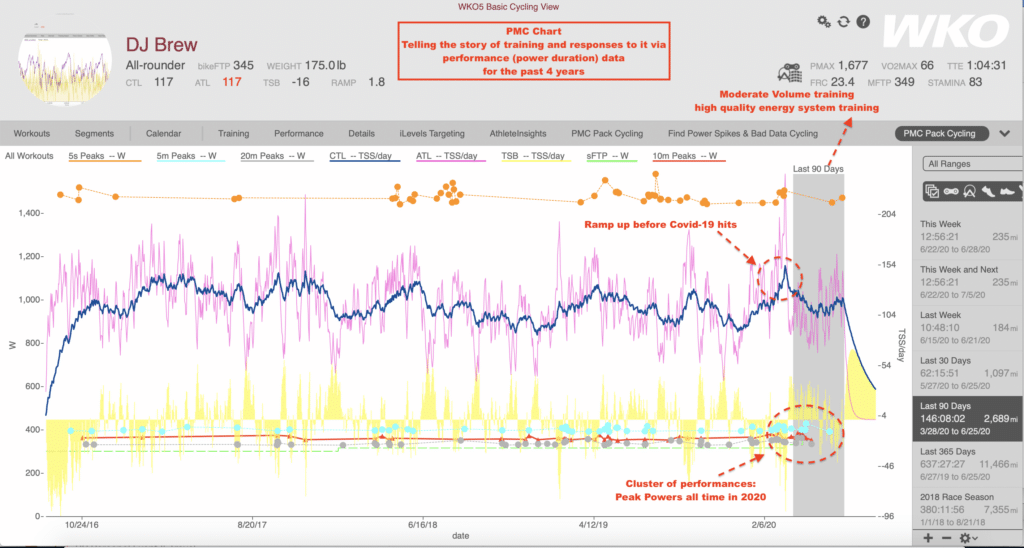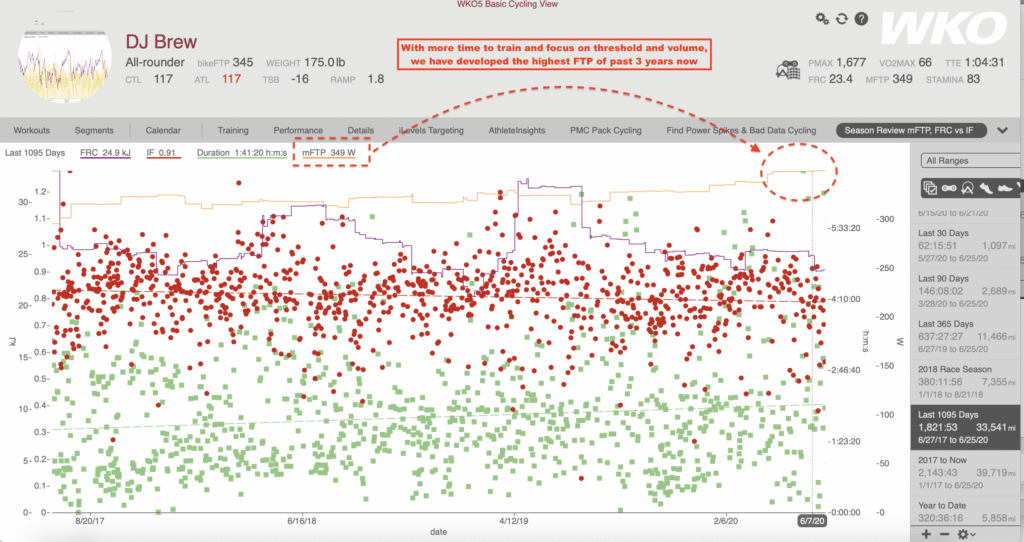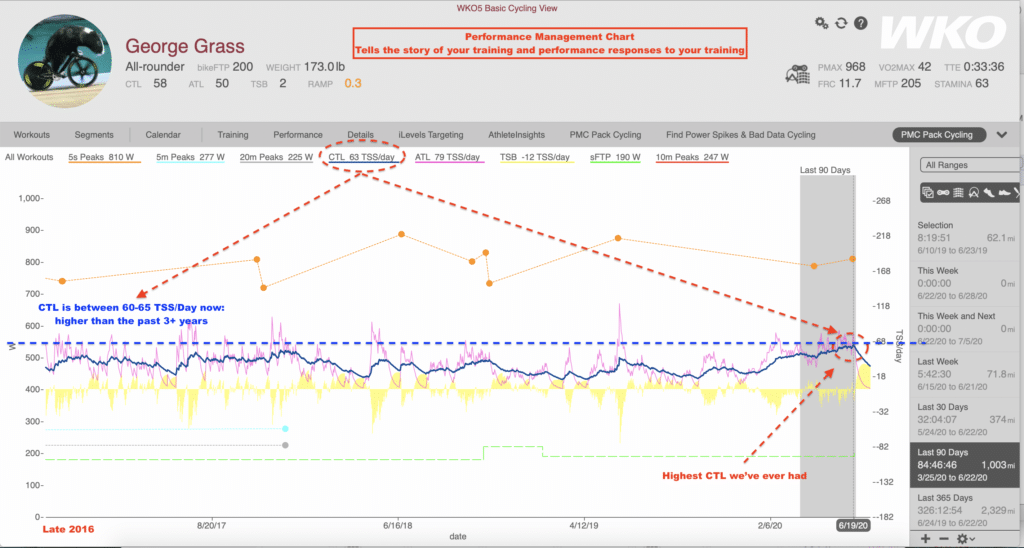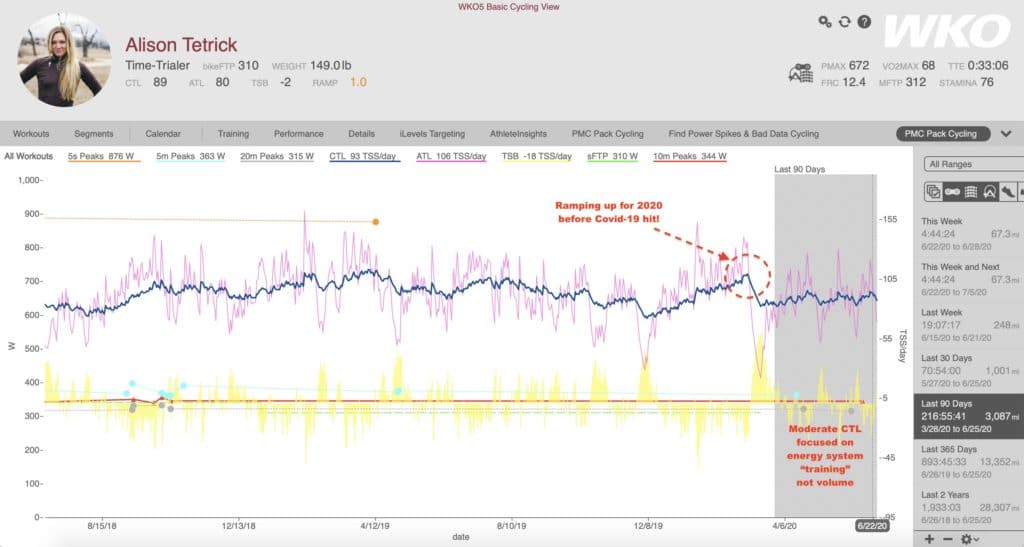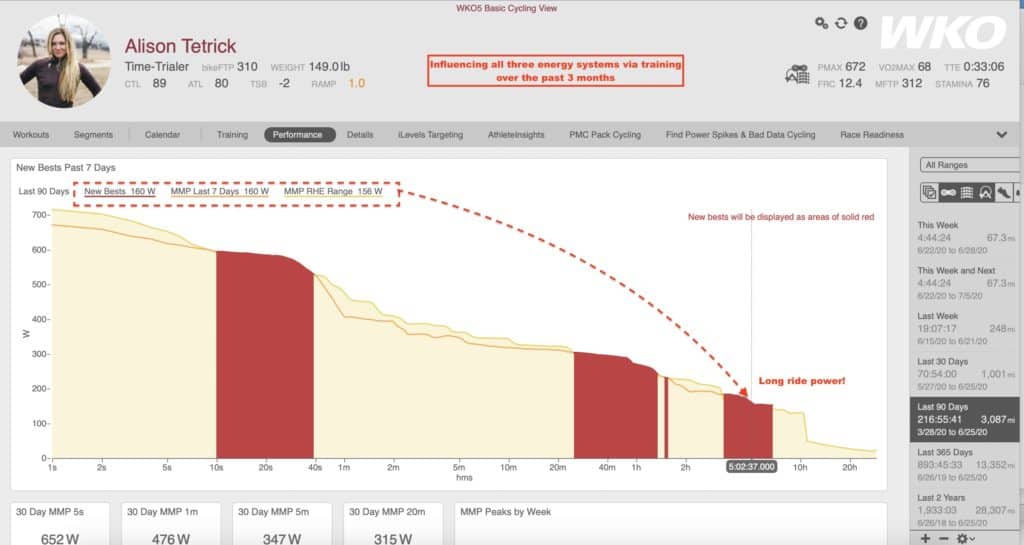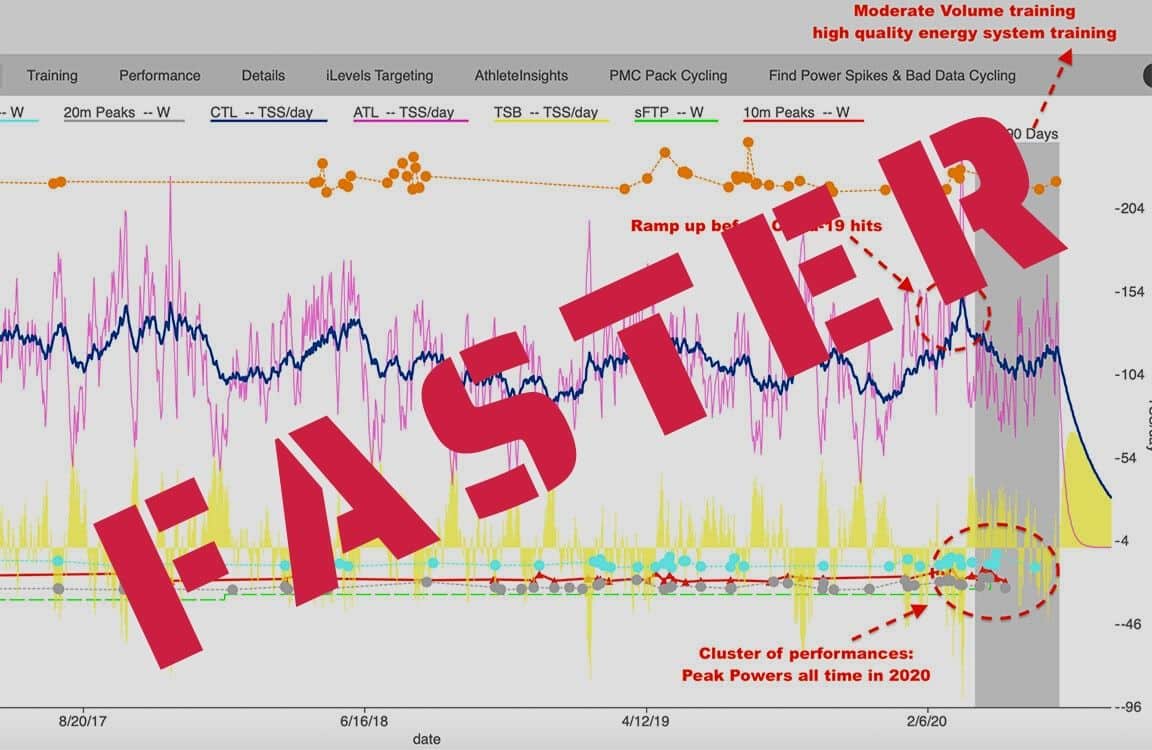
In 90 Days, These Cyclists Got Faster Than Ever. Here’s How They Did It.
By Chris Carmichael and Coach Adam Pulford,
As the wave of cancellations and postponements swept spring and summer cycling events off the calendar, athletes were understandably disappointed, but months later we’re seeing record-setting performances by amateur riders, masters racers, and even pros. To show you how they did it, I sat down with CTS Pro Coach Adam Pulford to look at specific examples from the athletes he works with. Everything these athletes did to achieve new personal bests are things you can do, too.
They created “Deep Fitness” with focused training blocks
DJ Brew is a father, husband, and police officer in Washington, D.C. Event with his other commitments, he manages to train and race as a Category 1 on the road. In February, DJ was ramping up his training in preparation for the start of the road and criterium season on the East Coast. This is illustrated by the blue line showing Chronic Training Load (CTL) on his TrainingPeaks Performance Management Chart.
With events cancelled and uncertainty about the 2020 race calendar, Coach Adam and DJ reduced training volume and turned the focus to improving power at lactate threshold. Over the next few months, DJ set his highest mFTP (modeled Functional Threshold Power) of the past 4 years. In the screenshot from WKO5, you can see that his mFTP fluctuated but stayed within a relatively stable range for three years, and the most significant increase happened during the pandemic.
Feel Stronger in 6 Weeks — No Matter Your Age
Climbs feel steeper? Recovery slower?
You’re not done getting faster — you just need a smarter plan.
The 6-Week Masters Power Build Coaching Program is designed for cyclists 50+ who want to boost power, recover faster, and ride stronger — all with expert 1:1 coaching.
- Personalized 6-Week Training Plan
- 1:1 Coaching + TrainingPeaks Premium
- Mobility & Strength Bonus Guides
💪 Guarantee: Stronger or free.
Start your 6-week journey for $149What you should do
A lot of cyclists added training hours because aspects of the pandemic opened up available time. When your intensities are all over the map you may not accumulate enough specific time-at-intensity over a period of days and weeks to avoid plateauing. DJ rode less total volume, but at more consistent intensities, and as a result he accumulated effective time-at-intensity; and he achieved better adaptation because she had less generalized fatigue to recover from. Without events to prepare for, spend 4 weeks focused on a narrower intensity range (like an aerobic endurance block, a threshold block, or a sprint block).
They paid more attention to warmup and cooldown
When athletes shifted to working at home and generally reducing their interactions outside the house, they unlocked additional training time. This led to longer rides, but more specifically to longer warmups and cooldowns within those rides. They didn’t necessarily spend more time in power ranges near and above threshold. Instead, many riders extended their pre-interval warmup and included more structure in their warmups.
The impact this has on fitness is two-fold. Consistently adding even 10-15 minutes at low intensity increases monthly riding volume, and all of that time counts toward building aerobic conditioning. Second, a better warmup helps you achieve more time at target power outputs during an interval workout, which increases training quality.
This is illustrated by George Grass’s Performance Management Chart. George is a 62-year-old attorney who splits his free time between road cycling and motorcycle racing. Between February and June, George has increased his Training Stress Score per day to between 60-65 TSS/day, which has gradually improved his fitness, as illustrated by the blue Chronic Training Load line in the figure below, to its highest level in three years.
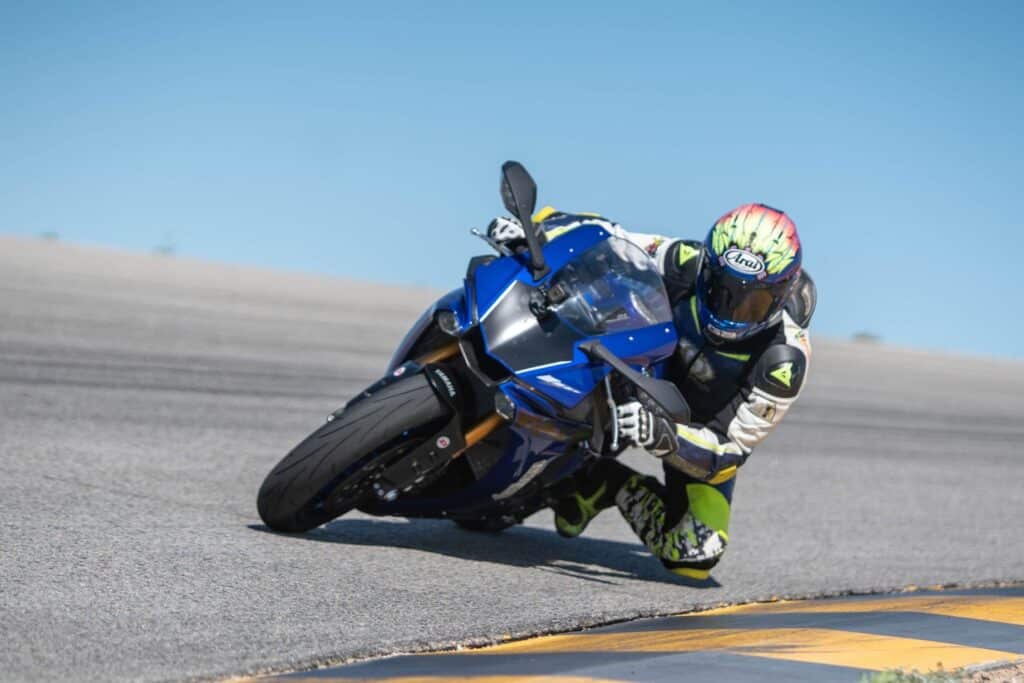
George Grass doesn’t just go fast on a bicycle!
What you should do
Many cyclists are creatures of habit and take a familiar route to the place they do intervals. Look for a longer route, and then take the long way home after you’re done. On the indoor trainer, do more than just spin easy for a few minutes. Incorporate a structured warmup before your interval session or virtual group ride, and make sure it includes some 30-second and 1-minute hard efforts to get your energy systems primed for the work ahead.
They took proper Recovery Blocks
Before Alison Tetrick was a gravel racer and industry influencer, she was one of the fastest road and time trial racers in the women’s pro peloton. She was one of the first pro road cyclists to shift gears and focus on gravel, winning the DK 200 in 2017 and Gravel Worlds in 2019. With her 2020 sights set on ultradistance gravel races, Alison was ramping up her training volume and Chronic Training Load (CTL) before COVID19 hit the US, as illustrated by the blue line in her TrainingPeaks Performance Management Chart.
You can see from Alison Tetrick’s TrainingPeaks Performance Management Chart that a prolonged rest period was the initial response to the uncertainty caused by the pandemic. This was very common across the board for CTS Athletes earlier this year. With so much uncertainty around schools and businesses closing, events being cancelled, and jobs moving to at-home status, training wasn’t high on the priority list.
► Free Cycling Training Assessment Quiz
Take our free 2-minute quiz to discover how effective your training is and get recommendations for how you can improve.
Following the rest period, Coach Adam and Alison changed the focus of her training from April into June. Instead of maxing out the weekly volume she could withstand, they focused on fewer overall hours and spent more of the remaining time at specific power intensities at and below lactate threshold. While it looks like Alison’s fitness stagnated between April and June because her CTL – commonly thought of as a rider’s fitness level – fluctuated but only trended upward very slightly, a look at her peak performances during the same timeframe tells a different story. At the end of June, Alison recorded her best 5-hour power output of the spring and her best 50-60-minute power output of the past 2 YEARS!
What you should do
Try adding an extra rest day between your hardest workouts, and when you would normally take a 4- to 5-day break for active recovery, add two days. A significant (2+ weeks) rest period in March is not typical for endurance athletes preparing for spring and summer goals, but as we often see with athletes who have unanticipated breaks due to injury, the extra rest opened up capacity for accelerated progress in the weeks after. If you haven’t taken a prolonged recovery period, consider giving yourself a two week break even though it’s summer. The extra rest will do wonders for your next training block.
They Cooked More
With restaurants closed, business travel suspended, and everyone working at home, athletes who normally ate 5+ meals per week in restaurants transitioned to more home cooking. Athletes often try to make good choices in restaurants, but there are many things we can’t control and we have to make compromises. Eating at home allows athletes to control the ingredients and their preparation, and in many cases this manifests as increased consumption of fresh fruit and vegetables, smaller portions, lower daily sodium intake, and less junk food.
Some athletes used the opportunity to make some dietary changes they had long thought about, whether that was going vegetarian or vegan, or eliminating added sugar. Because of the overall increased stress from dealing with the pandemic, CTS Coaches did not encourage proactive weight loss from February through April, and longer in some cases. Nonetheless, the increased training time and improved dietary quality from cooking at home did result in modest weight loss for many athletes.
What you should do
You have probably been eating more at home, too, but perhaps you’re relying on frozen prepared foods or boxed mixes more than you need to. Or you’ve settled in to a rotation of the same 4-5 staple dishes you know how to prepare. Branch out, take advantage of the abundance of fresh produce and the time to prepare it, and clean out the cupboards and freezer of the old stuff you have hanging around. And perhaps most of all, cook and eat together with your family. In addition to the relationship benefits, eating together tends to make meals last longer, which helps you register the feeling of being full before you’ve overfilled yourself.
They Slept More
While some athletes lost sleep due to anxiety around the personal and professional implications of the pandemic, more were able to increase weekly sleep hours and improve sleep quality. Working at home and eliminating commutes meant people could wake up later or wake up without alarms. Similarly, the lack of a homeward commute saved time in the evening so tasks were completed earlier, facilitating earlier bedtimes.
Pro athletes typically sleep more than time-crunched and masters athletes, but Coach Adam particularly noticed that from February through June his masters athletes were catching up to the pros in terms of weekly sleep duration and reported quality of sleep.
What you should do
As you’re getting ready for bed, there are steps you can take to get to sleep more quickly and achieve more restful sleep. A drop in core temperature is a key component of falling and staying asleep, and cooling the room helps facilitate the drop in core temperature. Make the room dark, and stop working on your laptop or playing on your phone at least an hour before going to bed.
They Drank Less Alcohol
The reduction in business travel, outings to restaurants, and get-togethers with friends resulted in a reduction in alcohol consumption for many athletes. In many cases, athletes didn’t purposely reduce or stop drinking alcohol; they stopped because their social circumstances changed. A common thread in conversations with athletes regarding alcohol was that they didn’t realize how frequently they had been consuming alcohol because it had become such a normal component of social gatherings. Reducing alcohol consumption was associated with improved sleep quality, lower weekly calorie intake, and improved training performance.
What you should do
Alcohol doesn’t do anything positive for your training performance. That doesn’t mean you have to abstain completely, but it does mean that reducing or eliminating alcohol can be a step toward improved performance. Some people – including athletes – also increase their alcohol consumption as a coping mechanism for increased stress or anxiety. If you find alcohol consumption is interfering with your relationships, career, health, and/or fitness, I encourage you to talk with a qualified medical or mental health professional.
Summary
Based on feedback from CTS Coaches and a closer review of Coach Adam Pulford’s athlete data, amateur, masters, and professional cyclists improved their performance from February through June 2020 – during the COVID19 pandemic – by:
- Reducing CTL, largely through a reduction in training intensity, and focusing on developing deeper aerobic conditioning and greater endurance at lactate threshold intensity.
- Warming up more completely, which improved workout quality and made individual workouts a bit longer, which added up to increased total monthly training volume.
- Resting more, with longer and more frequent recovery periods between interval workouts and training blocks.
- Sleeping more, by waking up later because of the elimination of daily commutes.
- Cooking more, which led to increased nutrient quality and smaller portions.
- Drinking less, which improved sleep quality and reduced weekly calorie intake.
► FREE Mini-Course: Learn How to Maximize Your Limited Training Time
Learn step-by-step how to overcome limited training time and get faster. Walk away with a personalized plan to increase your performance.
"*" indicates required fields

